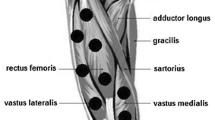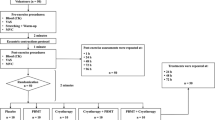Abstract
The purpose of the present study was to determine the effect of low level laser therapy (LLLT) treatment before knee extensor eccentric exercise on indirect markers of muscle damage. Thirty-six healthy men were randomized in LLLT group (n = 18) and placebo group (n = 18). After LLLT or placebo treatment, subjects performed 75 maximal knee extensors eccentric contractions (five sets of 15 repetitions; velocity = 60° seg−1; range of motion = 60°). Muscle soreness (visual analogue scale—VAS), lactate dehydrogenase (LDH) and creatine kinase (CK) levels were measured prior to exercise, and 24 and 48 h after exercise. Muscle function (maximal voluntary contraction—MVC) was measured before exercise, immediately after, and 24 and 48 h post-exercise. Groups had no difference on kineanthropometric characteristics and on eccentric exercise performance. They also presented similar baseline values of VAS (0.00 mm for LLLT and placebo groups), LDH (LLLT = 186 IU/l; placebo = 183 IU/l), CK (LLLT = 145 IU/l; placebo = 155 IU/l) and MVC (LLLT = 293 Nm; placebo = 284 Nm). VAS data did not show group by time interaction (P = 0.066). In the other outcomes, LLLT group presented (1) smaller increase on LDH values 48 h post-exercise (LLLT = 366 IU/l; placebo = 484 IU/l; P = 0.017); (2) smaller increase on CK values 24 h (LLLT = 272 IU/l; placebo = 498 IU/l; P = 0.020) and 48 h (LLLT = 436 IU/l; placebo = 1328 IU/l; P < 0.001) post-exercise; (3) smaller decrease on MVC immediately after exercise (LLLT = 189 Nm; placebo = 154 Nm; P = 0.011), and 24 h (LLLT = 249 Nm; placebo = 205 Nm; P = 0.004) and 48 h (LLLT = 267 Nm; placebo = 216 Nm; P = 0.001) post-exercise compared with the placebo group. In conclusion, LLLT treatment before eccentric exercise was effective in terms of attenuating the increase of muscle proteins in the blood serum and the decrease in muscle force.



Similar content being viewed by others
References
Al-Watban FA, Zhang XY, Andres BL (2007) Low-level laser therapy enhances wound healing in diabetic rats: a comparison of different lasers. Photomed Laser Surg 25:72–77
Avni D, Levkovitz S, Maltz L, Oron U (2005) Protection of skeletal muscles from ischemic injury: low-level laser therapy increases antioxidant activity. Photomed Laser Surg 23:273–277
Baroni BM, Leal Junior ECP, Geremia JM, Diefenthaeler F, Vaz MA (2010) Effect of light emmiting diodes therapy (LEDT) on knee extensor muscle fatigue. Photomed Laser Surg (in press)
Brown SJ, Child RB, Day SH, Donnelly AE (1997) Exercise-induced skeletal muscle damage and adaptation following repeated bouts of eccentric muscle contractions. J Sports Sci 15:215–222
Byrne C, Twist C, Eston R (2004) Neuromuscular function after exercise-induced muscle damage—theoretical and applied implications. Sports Med 34:49–69
Chapman D, Nexton M, Sacco P, Nosaka K (2006) Greater muscle damage induced by fast versus slow velocity eccentric exercise. Int J Sports Med 27:591–598
Chen TC, Nosaka K, Sacco P (2007) Intensity of eccentric exercise, shift of optimum angle, and the magnitude of repeated-bout effect. J Appl Physiol 102:992–999
Cheung K, Hume P, Maxwell L (2003) Delayed onset muscle soreness—treatment strategies and performance factors. Sports Med 33:145–164
Chow RT, Johnson MI, Lopes-Martins RA, Bjordal JM (2009) Efficacy of low-level laser therapy in the management of neck pain: a systematic review and meta-analysis of randomised placebo or active-treatment controlled trials. Lancet 374:1897–1908
Clarkson PM, Hubal MJ (2002) Exercise-induced muscle damage in humans. Am J Phys Med Rehabil 81:S52–S69
Craig JA, Barron J, Walsh DM, Baxter GD (1999) Lack of effect of combined low-intensity laser therapy/phototherapy (CLILT) on delayed onset muscle soreness in humans. Lasers Surg Med 24:223–230
Cressoni MD, Dib Giusti HH, Casarotto RA, Anaruma CA (2008) The effects of a 785-nm AlGaInP laser on the regeneration of rat anterior tibialis muscle after surgically-induced injury. Photomed Laser Surg (Ahead of print). doi:10.1089/pho.2007.2150
Douris P, Southard V, Ferrigi R, Grauer J, Katz D, Nascimento C, Podbielski P (2006) Effect of phototherapy on delayed onset muscle soreness. Photomed Laser Surg 24:377–382
French DN, Thompson KG, Garland SW, Barnes CA, Portas MD, Hood PE, Wilkes G (2008) The effects of contrast bathing and compression therapy on muscular performance. Med Sci Sports Exerc 40:1297–1306
Fridén J, Lieber RL (2001) Eccentric exercise-induced injuries to contractile and cytoskeletal muscle fibre components. Acta Physiol Scand 171:321–326
Hough T (1902) Ergographic studies in muscular soreness. Am J Physiol 7:76–92
Howatson G, van Someren KA (2008) The prevention and treatment of exercise-induced muscle damage. Sports Med 38:483–450
Huang YY, Chen AC, Carroll JD, Hamblin MR (2009) Biphasic dose response in low level light therapy. Dose Response 7:358–383
Jamurtas AZ, Theocharis V, Tofas T, Tsiokanos A, Yfanti C, Paschalis V, Koutedakis Y, Nosaka K (2005) Comparison between leg and arm eccentric exercises of the same relative intensity on indices of muscle damage. Eur J Appl Physiol 95:179–185
Leal Junior EC, Lopes-Martins RB, Rossi RP, De Marchi T, Baroni BM, Godoi V, Marcos RL, Ramos L, Bjordal JM (2009) Effect of cluster multi-diode light emitting diode therapy (LEDT) on exercise-induced skeletal muscle fatigue and skeletal muscle recovery in humans. Lasers Surg Med 41:572–577
Leal Junior EC, Lopes-Martins RA, de Almeida P, Ramos L, Iversen VV, Bjordal JM (2010) Effect of low-level laser therapy (GaAs 904 nm) in skeletal muscle fatigue and biochemical markers of muscle damage in rats. Eur J Appl Physiol 108:1083–1088
Liu XG, Zhou YJ, Liu TC, Yuan JQ (2009) Effects of low-level laser irradiation on rat skeletal muscle injury after eccentric exercise. Photomed Laser Surg 27:863–869
Marfell-Jones M, Olds T, Stewart A, Carter L (2006) International standards for anthropometric assessment. ISAK, Potchefstroom (South Africa)
Morgan DL (1990) New insights into the behavior of muscle during active lengthening. Biophys J 57:209–221
Morgan DL, Allen DG (1999) Early events in stretch-induced muscle damage. J Appl Physiol 87:2007–2015
Nikolaidis MG, Jamurtas AZ, Paschalis V, Fatouros IG, Koutedakis Y, Kouretas D (2008) The effect of muscle-damaging exercise on blood and skeletal muscle oxidative stress: magnitude and time-course considerations. Sports Med 38:579–606
Nosaka K, Clarkson PM (1996) Variability in serum creatine kinase response after eccentric exercise of the elbow flexors. Int J Sports Med 17:120–127
Nosaka K, Sakamoto K, Newton M, Sacco P (2001) How long does the protective effect on eccentric exercise-induced muscle damage last? Med Sci Sports Exerc 33:1490–1495
Oliveira FS, Pinfildi CE, Parizoto NA, Liebano RE, Bossini PS, Garcia EB, Ferreira LM (2009) Effect of low level laser therapy (830 nm) with different therapy regimes on the process of tissue repair in partial lesion calcaneous tendon. Lasers Surg Med 41:271–276
Proske U, Morgan DL (2001) Muscle damage from eccentric exercise: mechanism, mechanical signs, adaptation and clinical applications. J Physiol 537:333–345
Rizzi CF, Mauriz JL, Freitas Corrêa DS, Moreira AJ, Zettler CG, Filippin LI, Marroni NP, González-Gallego J (2006) Effects of low-level laser therapy (LLLT) on the nuclear factor (NF)-kappaB signaling pathway in traumatized muscle. Lasers Surg Med 38:704–713
Rochkind S, Geuna S, Shainberg A (2009) Chapter 25: phototherapy in peripheral nerve injury: effects on muscle preservation and nerve regeneration. Int Rev Neurobiol 87:445–464
Silveira PC, Silva LA, Fraga DB, Freitas TP, Streck EL, Pinho R (2009) Evaluation of mitochondrial respiratory chain activity in muscle healing by low-level laser therapy. J Photochem Photobiol B 95:89–92
Sussai DA, Carvalho PTC, Dourado DM, Belchior ACG, Reis FA, Pereira DM (2010) Low-level laser therapy attenuates creatine kinase levels and apoptosis during forced swimming in rats. Lasers Med Sci 25:115–120
Totsuka M, Nakaji S, Suzuki K, Sugawara K, Sato K (2002) Break point of serum creatine kinase release after endurance exercise. J Appl Physiol 93:1280–1286
Váczi M, Costa A, Rácz L, Tihanyi J (2009) Effects of consecutive eccentric training at different range of motion on muscle damage and recovery. Acta Physiol Hung 96:459–468
Warren GL, Lowe DA, Armstrong RB (1999) Measurement tools used in the study of eccentric contraction-induced injury. Sports Med 27:43–59
White JP, Wilson JM, Austin KG, Greer BK, St. John N, Panton LB (2008) Effect of carbohydrate-protein supplement timing on acute exercise-induced muscle damage. J Int Soc Sports Nutr 5:5
Wilson JM, Kim JS, Lee SR, Rathmacher JA, Dalmau B, Kingsley JD, Koch H, Manninen AH, Saadat R, Panton LB (2009) Acute and timing effects of beta-hydroxy-beta-methylbutyrate (HMB) on indirect markers of skeletal muscle damage. Nutr Metab (Lond) 6:6
Xu X, Zhao X, Liu TC, Pan H (2008) Low-intensity laser irradiation improves the mitochondrial dysfunction of C2C12 induced by electrical stimulation. Photomed Laser Surg 26:197–202
Yamaura M, Yao M, Yaroslavsky I, Cohen R, Smotrich M, Kochevar IE (2009) Low level light effects on inflammatory cytokine production by rheumatoid arthritis synoviocytes. Lasers Surg Med 41:282–290
Acknowledgments
The authors would like to thank Coordenação de Aperfeiçoamento de Pessoal de Nível Superior (CAPES-Brazil) and Conselho Nacional de Pesquisa (CNPq-Brazil) for financial support and our colleagues Rodrigo Rodrigues and Giovani dos Santos Cunha for technical assistance during data collection.
Author information
Authors and Affiliations
Corresponding author
Additional information
Communicated by Arnold de Haan.
Rights and permissions
About this article
Cite this article
Baroni, B.M., Leal Junior, E.C.P., De Marchi, T. et al. Low level laser therapy before eccentric exercise reduces muscle damage markers in humans. Eur J Appl Physiol 110, 789–796 (2010). https://doi.org/10.1007/s00421-010-1562-z
Accepted:
Published:
Issue Date:
DOI: https://doi.org/10.1007/s00421-010-1562-z




